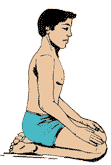|
|
|
Vajrasana (Adamantine pose) and suptavajrasana
 |
|
 |
| 1. |
This
is a sitting posture.
|
| |
|
 |
|
| 1. |
Bend
the legs.
|
| 2. |
Place
them under the hips.
|
| 3. |
The
soles of the feet are facing back and upwards.
|
| 4. |
The
buttocks rest between the heels. Touch the toes to each
other.
|
| 5. |
Rest
the hands on the knees.
|
| 6. |
Keep
the spine neck and head erect.
|
|
To
perform Suptavajrasana.
|
| 1. |
assume
the previous position.
|
| 2. |
Bend
backward using your hands for support.
|
| 3. |
Place
the head on the ground, keeping the neck relaxed.
|
| 4. |
Keep
the knees together. Rest the hands on the thighs. Breathe normally.
|
| 5. |
To
conclude the posture, turning to the left side with the support
of your left hand, raise yourself up while exhaling.
|
| 6. |
Return
to the original vajrasana position.
|
| |
|
 |
|
| |
Practice
this posture as much as you can. After meals, perform this asana
for at least ten minutes.
|
| |
|
 |
|
| 1. |
This
asana activates the functions of digestion, develops memory
power and increases energy of the brain.
|
| 2. |
It
helps in reducing sleepiness, hot temper, and excessive fat
in the thighs.
|
| 3. |
Due
to increased circulation of blood, the thigh muscles, and the
backbone and shoulders tone up.
|
| 4. |
In
turn, all of those areas work in the right way.
|
Back
|
|
 |